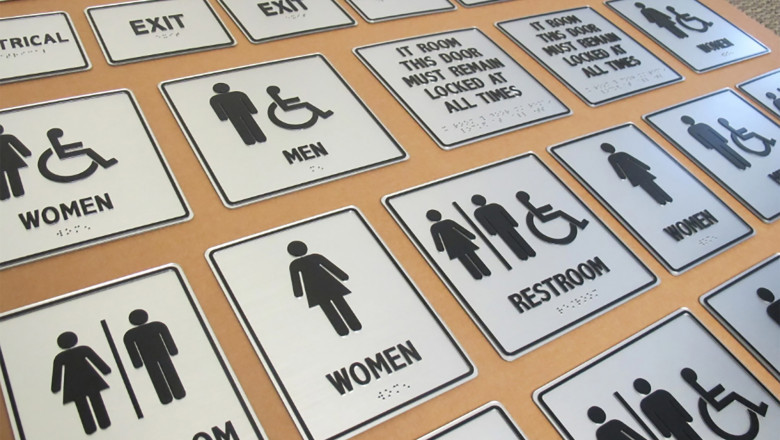views
In a world striving for inclusivity, ensuring that all individuals, regardless of ability, can navigate public spaces safely and comfortably is essential. One key element of accessible design is ADA compliant signage. These signs are not just helpful—they’re legally required in many settings. Whether you're a business owner, property manager, or interior designer, understanding ADA sign requirements is critical to creating accessible environments.
What Are ADA Compliant Signs?
ADA compliant signs are signage designed to meet the standards set by the Americans with Disabilities Act (ADA). This federal law, enacted in 1990, prohibits discrimination against individuals with disabilities and ensures they have the same rights and opportunities as everyone else. Part of this includes providing accessible wayfinding and identification through standardized signage.
These signs are specially crafted to be readable by people with visual impairments and include features such as:
-
High-contrast colors
-
Sans-serif fonts
-
Braille translation
-
Tactile (raised) letters
-
Specific mounting locations and heights
Why Are ADA Signs Important?
-
Legal Compliance:
Businesses and facilities open to the public are required by law to comply with ADA regulations. Failure to do so can result in fines, legal issues, and reputational damage. -
Inclusivity and Accessibility:
ADA signs empower individuals with disabilities to move through buildings and public areas independently. Clear and accessible signs make daily life easier and foster a more inclusive society. -
Safety and Navigation:
In emergencies, properly labeled exits, restrooms, and safety areas can be life-saving. ADA compliant signs ensure that everyone, including those with visual impairments, can respond quickly and safely.
Where Are ADA Signs Required?
ADA signage is mandatory in a wide range of facilities, including:
-
Offices
-
Schools and universities
-
Hospitals
-
Hotels
-
Retail stores
-
Government buildings
-
Apartment complexes
Specific areas where ADA signs are required include:
-
Restrooms: Must have tactile and Braille labels indicating gender and accessibility.
-
Room Identifications: Offices, conference rooms, classrooms, and other permanent spaces must have ADA signage.
-
Exit and Emergency Signs: Must be readable and accessible to all.
-
Elevators and Stairways: Should include both tactile and visual elements.
-
Directional and Informational Signs: Must be clear, readable, and mounted at accessible heights.
Key Design Requirements for ADA Compliant Signs
To be compliant, signs must follow specific design standards, such as:
-
Font and Lettering:
-
Use simple, sans-serif fonts (e.g., Helvetica, Arial).
-
Avoid italic, script, or decorative typefaces.
-
Characters must be uppercase and raised 1/32 inch from the surface.
-
-
Braille:
-
Grade II Braille must be included beneath the corresponding text.
-
Braille must be domed and rounded, not flat.
-
-
Contrast and Color:
-
The background and text must have high contrast (light-on-dark or dark-on-light).
-
Reflective finishes should be avoided to prevent glare.
-
-
Mounting and Placement:
-
Signs should be mounted 48 to 60 inches above the ground to the centerline of the sign.
-
They must be located on the latch side of doors (or the nearest adjacent wall if no latch side exists).
-
-
Tactile Elements:
-
All lettering must be tactile (raised) and easy to touch and read.
-
Graphics, pictograms, and icons used must be accompanied by a verbal description in tactile text.
-
Custom ADA Signs: A Blend of Compliance and Design
While ADA signs are regulated, that doesn’t mean they need to be dull. Custom ADA signage allows businesses to stay compliant while maintaining their brand identity. From sleek acrylic finishes to brushed metal and wood textures, you can blend functionality with aesthetics.
Custom options can include:
-
Company logos
-
Brand colors (with the required contrast)
-
Unique shapes and materials
-
Integration with other interior design elements
Common Mistakes to Avoid
-
Using stylized fonts that are hard to read
-
Forgetting to include Braille or tactile text
-
Incorrect mounting height or placement
-
Poor color contrast
-
Non-compliant materials that cause glare
Even small mistakes can result in non-compliance, so it’s always a good idea to work with experienced ADA signage manufacturers or consultants who understand the guidelines inside out.
Staying Updated with ADA Standards
ADA regulations are periodically updated to address evolving needs and technologies. Staying current with these updates is essential for ongoing compliance. The most reliable sources include:
-
The U.S. Access Board (access-board.gov)
-
The ADA National Network (adata.org)
Final Thoughts
ADA compliant signs are more than just regulatory requirements—they’re a reflection of your organization’s values. By making your space accessible, you're not only adhering to the law but also creating a welcoming and inclusive environment for everyone.
Whether you're outfitting a new office, renovating a retail space, or simply upgrading your existing signage, investing in high-quality, ADA-compliant signs is a smart and socially responsible move. It's good for business—and even better for people.














Comments
0 comment